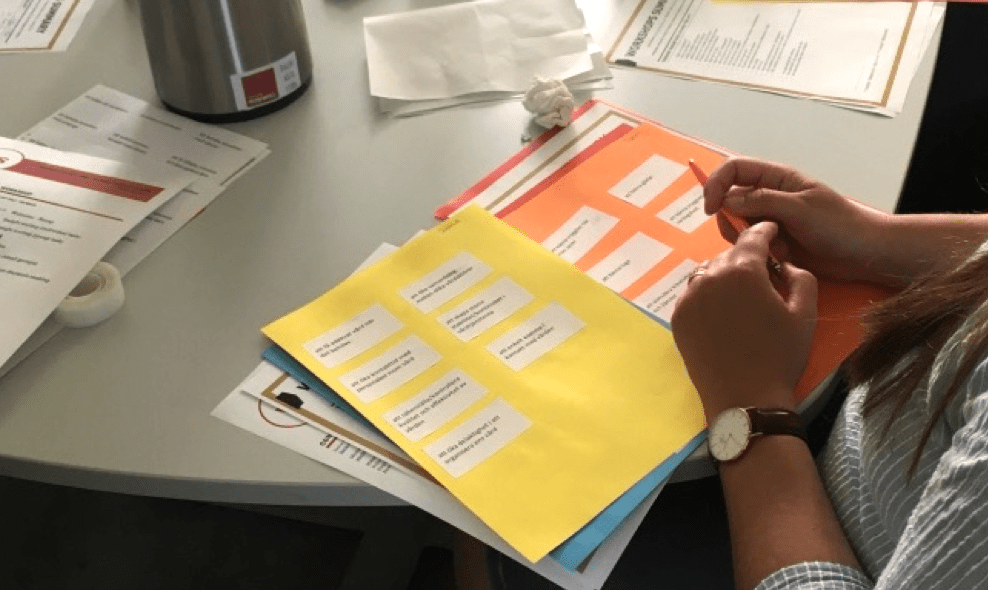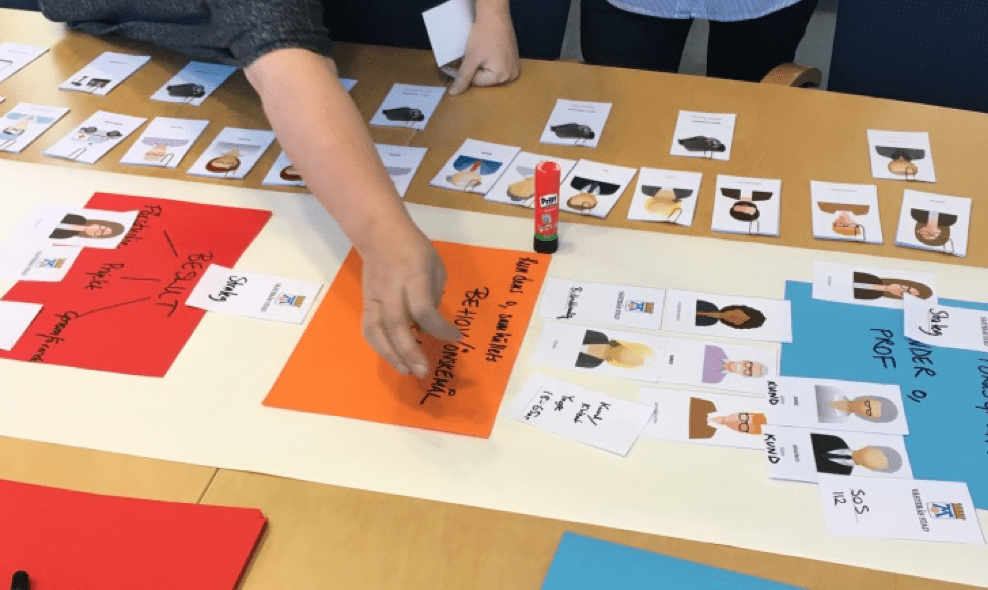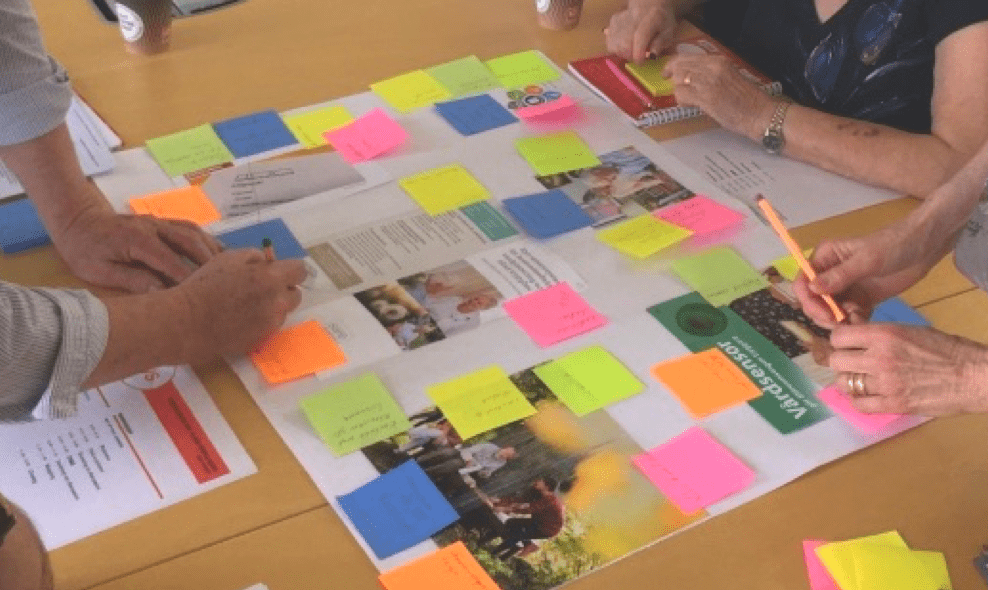Text
About the project
The SinS project was aimed to foster social innovation in welfare technology from a human-centered design perspective. Such a perspective relies on the cooperation between ‘experts’ and ‘nonexperts’ by creating tools that enable those people that experts are designing for to take a more skillful part in the process and achieve good results, which can be eventually embraced.
The goal is to develop products or services that match potential users’ practices, needs, and preferences. This goal was consistent with SinS’ purpose.
The SinS project has been conducted through traditional sociological techniques, such as:
- Semi-structured interview to spokespeople for the organizations involved;
- Focus groups with spokespeople for the organizations involved;
- Passing ethnography conducted on the occasion of municipal meetings and public events on welfare technology (i.e. Mötesplats Välfärdsteknologi och E-hälsa). Ethnographical observation also took place on the occasion of workshops with older people.



Several workshops with older people and professionals representing key professions in welfare technology were organized. A participatory approach informed workshop activities aimed at identifying problems and tensions, framing them into the local context, and discussing possible solutions through design methods, such as:
- Photo elicitation: to elicit needs and expectations of older people and discussing them by involving professionals too.
- Concept sorting: to organize the results emerging from the previous activity from the professionals’ perspective.
- Persona combined with User Journey Maps: to track older people’s steps through an entire experience of potential rehabilitation at home after an injury, from the perspective of both older people and professionals. These techniques were used also for imagining a welfare technology implementation process by gathering different professionals.
The Open Space Technology method has been used to engage participants in a discussion on the collaboration between older people and municipalities, possible tools, and benefits of working together.
The LEGO® SERIOUS PLAY® method has been adopted to facilitate one meeting between partners’ representatives to identify competences to share which would improve the quality and efficiency of current services and encourage future collaborations in welfare technology matter.
Diffusion of the research results took place at national and international conferences, and via publications in peer-reviewed scholarly journals. Contact with the media and specialized magazines on welfare technology contributed to the public engagement. The researchers also presented part of the results at the MVTe 2018 exhibition and conference: an arena for professionals, companies, public sectors representatives to meet and discuss welfare technology.
%20Open-Space-Technology-min-1.png)
Publications, conference proceedings and selected media appearances
Cozza M., Crevani, L., Hallin, A., Schaeffer, J.  External link.(2018) “Future ageing: welfare technology practices for our future older selves”, Futures. The journal of policy, planning and futures studies, https://doi.org/10.1016/j.futures.2018.03.011
External link.(2018) “Future ageing: welfare technology practices for our future older selves”, Futures. The journal of policy, planning and futures studies, https://doi.org/10.1016/j.futures.2018.03.011 External link.
External link.
Cozza, M. External link. (2018) “Interoperability and convergence for welfare technology”, Springer International Publishing AG, part of Springer Nature 2018, J. Zhou and G. Salvendy (Eds.): ITAP 2018, LNCS 10927, pp. 13–24, 2018. https://doi.org/10.1007/978-3-319-92037-5_2
External link. (2018) “Interoperability and convergence for welfare technology”, Springer International Publishing AG, part of Springer Nature 2018, J. Zhou and G. Salvendy (Eds.): ITAP 2018, LNCS 10927, pp. 13–24, 2018. https://doi.org/10.1007/978-3-319-92037-5_2 External link.
External link.
Andersson, C., Cozza, M., Crevani, L., Schunnesson, J.  External link.(2018) “Infrastructuring for remote night monitoring: frictions in striving for transparency when digitalising care service”, 16th European Conference on Computer-Supported Cooperative Work, Nancy, France, 4-8 June, 2018 (ISSN 2510-2591), DOI: 10.18420/ecscw2018_006)
External link.(2018) “Infrastructuring for remote night monitoring: frictions in striving for transparency when digitalising care service”, 16th European Conference on Computer-Supported Cooperative Work, Nancy, France, 4-8 June, 2018 (ISSN 2510-2591), DOI: 10.18420/ecscw2018_006)
Crevani, L., Cozza, M.  External link.(2018) “Complementary representational practices for articulating matters of concern”, proceeding of the 5thParticipatory Innovation Conference 2018, Eskilstuna, Sweden, pp.270-277 http://pin-c.sdu.dk/2018.html
External link.(2018) “Complementary representational practices for articulating matters of concern”, proceeding of the 5thParticipatory Innovation Conference 2018, Eskilstuna, Sweden, pp.270-277 http://pin-c.sdu.dk/2018.html External link.
External link.
2018, 26 June: “En robot med uppdrag att rädda välfärden” [“A robot with a mission to save the welfare”], ETC-Ekonomi, https://www.etc.se/ekonomi/en-robot-med-uppdrag-att-radda-valfarden2018 External link.,
External link.,
21 February: “Brist på forskning som problematiserar välfärdsteknik” [“Lack of research that problematizes welfare technology”], Medicin-Digital Hälsa https://www.insiktmedicin.se/articles/512128/2018-02-21-10-58-53-brist-pa-forskning-som-problematiserar-valfardsteknik External link.
External link.
2016 External link., 14 December: “Så kan man samarbeta för att öka livskvaliteten hos äldre” [“This way you can work together to increase the older people’s quality of life”], Mälardalen University webpage - News
External link., 14 December: “Så kan man samarbeta för att öka livskvaliteten hos äldre” [“This way you can work together to increase the older people’s quality of life”], Mälardalen University webpage - News
Other initiatives providing support for the introduction of welfare technology
Our website offers support for those who want to collaborate on welfare technology issues, but if you want to know more about best practices or share your knowledge, there are more initiatives on the subject:
Platforms to share knowledge and experience
- Deladigitalt.se
 External link, opens in new window. – a platform to share knowledge with others in the public sector.
External link, opens in new window. – a platform to share knowledge with others in the public sector. - Different groups on social media.
Examples of best practices
- Nordic Welfare Center
 External link, opens in new window. – Toolbox for welfare technology.
External link, opens in new window. – Toolbox for welfare technology. - Mittköping
 External link, opens in new window. – Wiki describing an ideal municipality and how it works with welfare technology.
External link, opens in new window. – Wiki describing an ideal municipality and how it works with welfare technology. - Välfärd och hälsa
 External link, opens in new window. – Guidelines for the implementation of welfare technologies.
External link, opens in new window. – Guidelines for the implementation of welfare technologies.
